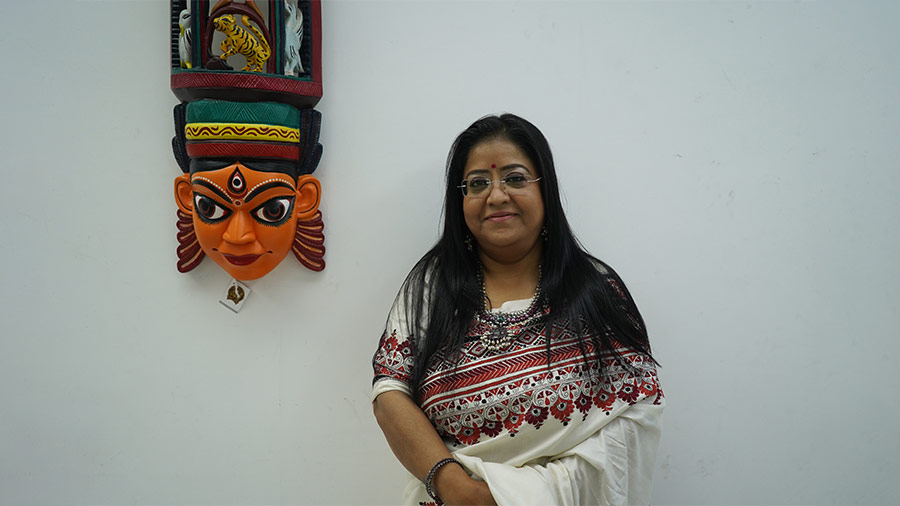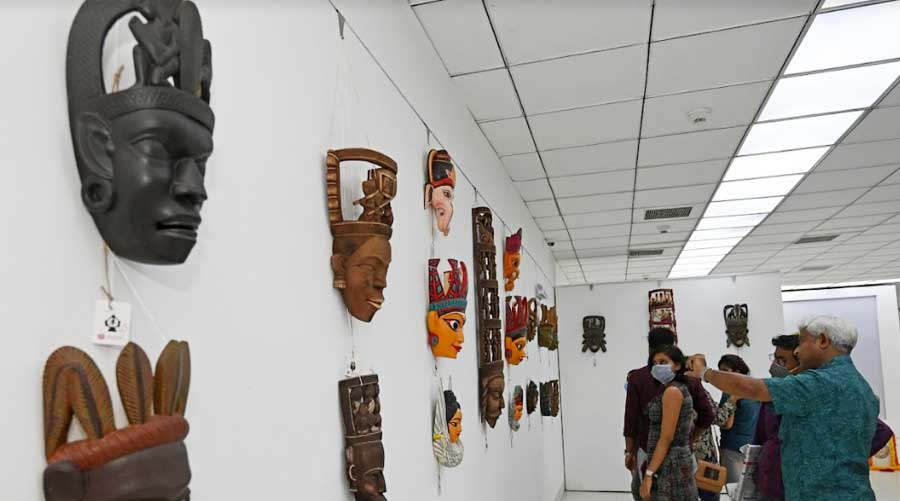West Bengal is known for its rich art and culture, and there is one form of art — mask-making — that needs attention and patronage. In order to tackle this, Sharmila Sen has been organising Sharmi’s Art Beyond Tradition since 2009. The 14th edition of the exhibition was inaugurated by Alokananda Roy on April 28, and the event saw a rush of art enthusiasts admiring masks across styles. On till May 1, from 2pm to 8pm, at Gaganendra Shilpa Pradarshashala. My Kolkata brings you the highlights from the opening day.

Painted conch shells from Purba Medinipur
Sharmila has been toiling to put the exhibition together for the past six months. “Some of the biggest masks took 25 days to make, and the smaller ones at least four days. My ideas were executed by my artist, Shankar Das, who hails from South Dinajpur and has been working with me since I started this project. This year’s exhibition is the culmination of the journey we started in 2009,” she said. There are a total of 97 masks at the exhibition.

Alokananda Roy, who inaugurated the workshop, said, ‘There can often be a gap between what you think and what comes out, but Sharmila’s work is a rare combination of thought and execution. The themes are vivid, and you don't need any explanation to appreciate them.’
For Sharmila, the mask's origin is as important as its presentation. This is why she practises the Dinajpur style of mask-making. “In masks from Dinajpur, every story is steeped in mythology, and the story is told on the mask’s headgear. In the mask embodying Durga, you can see her children in her headgear. Similarly, tribal masks have themes like hunting scenes, animals and cooking on the headgear.”

The tree trunk masks struck a chord with former Nandan director and WBERC ombudsman Yadav Mondal. ‘I have seen this exhibition grow from strength to strength and it is always a wonderful experience to come back. This one, in particular, is my favourite,’ he said
However, Sharmila’s favourites are the three masks embodying trees, which go well with the theme of the exhibition. “This year, I wanted to create awareness with my masks. The three central masks this year have birds living within and cradle ecology. I want them to depict how Mother Nature protects children, and emphasise on how global warming is threatening our planet, reinforcing the need to protect nature,” she said.
![The exhibition received appreciation from Sharmila’s longtime friend and filmmaker Shiboprosad Mukherjee. ‘Sharmila gave me a Durga mask that adorned my first flat after my wedding, and it remains in my living room to this day. I’m definitely going to pick up something from this exhibition, and this Ganesh mask [centre] has already caught my fancy!’](https://assets.telegraphindia.com/telegraph/2023/Apr/1682774603_dsc04410.jpg)
The exhibition received appreciation from Sharmila’s longtime friend and filmmaker Shiboprosad Mukherjee. ‘Sharmila gave me a Durga mask that adorned my first flat after my wedding, and it remains in my living room to this day. I’m definitely going to pick up something from this exhibition, and this Ganesh mask [centre] has already caught my fancy!’
The diverse themes impressed dancer Alokananda Roy the most, as she inaugurated the exhibition. A patron of arts, she urged people to give mask-making the due it deserves. “You don’t see too many masks these days, even though it’s a very creative art form. I found last year’s exhibition outstanding too, but Sharmila has surpassed herself this time,” she said.
One of Sharmila’s biggest moments was taking the exhibition to Delhi in 2018. “In Delhi, a lot of foreigners come and enquire about this art form. When I tell them that it is from Bengal, it makes me feel very proud. The biggest outcome of this exhibition is that it allows me to take art from my state to the world. I hope to take this not just on a pan-India level, but on the global platform as well,” she signed off.

